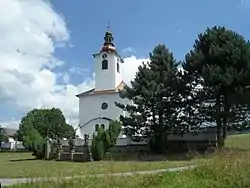Dolní Morava | |
|---|---|
 Church of Saint Aloysius Gonzaga | |
 Flag  Coat of arms | |
 Dolní Morava Location in the Czech Republic | |
| Coordinates: 50°7′21″N 16°47′58″E / 50.12250°N 16.79944°E | |
| Country | |
| Region | Pardubice |
| District | Ústí nad Orlicí |
| First mentioned | 1577 |
| Area | |
| • Total | 36.57 km2 (14.12 sq mi) |
| Elevation | 615 m (2,018 ft) |
| Population (2023-01-01)[1] | |
| • Total | 421 |
| • Density | 12/km2 (30/sq mi) |
| Time zone | UTC+1 (CET) |
| • Summer (DST) | UTC+2 (CEST) |
| Postal code | 561 69 |
| Website | www |
Dolní Morava (German: Mohrau) is a municipality and village in Ústí nad Orlicí District in the Pardubice Region of the Czech Republic. It has about 400 inhabitants.
Administrative parts
The villages of Horní Morava and Velká Morava are administrative parts of Dolní Morava.
Geography
Dolní Morava is located about 32 kilometres (20 mi) northeast of Ústí nad Orlicí and 72 km (45 mi) east of Pardubice, on the border with Poland. Most of the municipality lies in the Snieznik Mountains. The highest mountain of the range and one of the highest in the country, Králický Sněžník at 1,423 m (4,669 ft) above sea level, is situated in the northern part of the municipality on the Czech-Polish border. Klepáč, a mountain which is a triple point of the European watershed, is also located in the municipality on the Czech-Polish border.
The Morava river, which gave the name to the villages in the municipality, originates on Králický Sněžník. It flows across the municipality and forms here the historic boundary between Bohemia and Moravia.
History
The area around the Morava River was settled during the second half of the 16th century. The first written mention of Morava is from 1577, Velká Morava was first mentioned in 1564. Before 1720, it was split into two separate villages of Dolní Morava and Horní Morava, administered as parts of the Králíky estate. In 1850, the villages became three independent municipalities.[2]
Historically, the territory was inhabited mainly by ethnic Germans. After the World War II, they were expelled and partially replaced by Czech settlers. In 1960, Dolní Morava, Horní Morava and Velká Morava were merged into one municipality.[2]
Demographics
|
|
| ||||||||||||||||||||||||||||||||||||||||||||||||||||||
| Source: Censuses[3][4] | ||||||||||||||||||||||||||||||||||||||||||||||||||||||||
Sights
Sky Bridge 721, the longest suspension footbridge in the world, is located in the municipality. The 721 metres (2,365 ft) long bridge, located at an altitude of 1,110 m (3,640 ft) above sea level, was opened to the public in May 2022.[5]
The Church of Saint Aloysius Gonzaga was built in the Empire style in 1801. The rectory dates from 1802.[2]
References
- ↑ "Population of Municipalities – 1 January 2023". Czech Statistical Office. 2023-05-23.
- 1 2 3 "Územní plán Dolní Morava: Textová část" (in Czech). Obec Dolní Morava. November 2013. pp. 43–44. Retrieved 2022-07-07.
- ↑ "Historický lexikon obcí České republiky 1869–2011 – Okres Ústí nad Orlicí" (in Czech). Czech Statistical Office. 2015-12-21. pp. 3–4.
- ↑ "Population Census 2021: Population by sex". Public Database. Czech Statistical Office. 2021-03-27.
- ↑ "V Dolní Moravě se otevřel nejdelší visutý most pro pěší na světě. Ochránci přírody ho kritizují" (in Czech). Czech Television. 2022-05-09. Retrieved 2022-07-07.